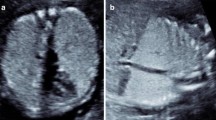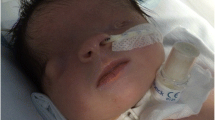Abstract
Congenital high airway obstruction syndrome (CHAOS) is a rare prenatal diagnosis consisting of a typical fetal triad of large hyperechogenic lungs, flattened or inverted diaphragms and ascites. Most cases are sporadic with unknown incidence. Before attempts of fetoscopic fetal salvage or ex utero intrapartum treatment (EXIT) are considered, additional malformations must be carefully excluded as CHAOS may be part of various monogenic conditions or chromosomal disorders. We report an unique family with autosomal dominant inheritance of CHAOS and variable expression in the affected father and two affected children. It is concluded that minor expression in one of the parents may be an important indicator for genetic counseling in CHAOS and management of future pregnancies.


Similar content being viewed by others
Abbreviations
- CCAML:
-
Congenital cystic adenomatoid malformation of the lungs
- CHAOS:
-
Congenital high airway obstruction syndrome
- CT:
-
Computerized tomography
- EXIT:
-
Ex utero intrapartum treatment
References
Baker DC Jr, Savetsky L (1966) Congenital partial atresia of the larynx. Laryngoscope 76:616–620
Bui TH, Grunewald C, Frenckner B, Kuylenstierna R, Dahlgren G, Edner A, Granstrom L, Sellden H (2000) Successful EXIT (ex utero intrapartum treatment) procedure in a fetus diagnosed prenatally with congenital high-airway obstruction syndrome due to laryngeal atresia. Eur J Pediatr Surg 10:328–333
Chen CP, Shih JC, Tzen CY, Lin YH, Wang W (2005) Recurrent short-rib polydactyly syndrome: prenatal three-dimensional ultrasound findings and associations with congenital high airway obstruction and pyelectasia. Prenat Diagn 25:417–418
Cohen MS, Rothschild MA, Moscoso J, Shlasko E (1998) Perinatal management of unanticipated congenital laryngeal atresia. Arch Otolaryngol Head Neck Surg 124:1368–1371
Crombleholme TM, Sylvester K, Flake AW, Adzick NS (2000) Salvage of a fetus with congenital high airway obstruction syndrome by ex utero intrapartum treatment (EXIT) procedure. Fetal Diagn Ther 15:280–282
DeCou JM, Jones DC, Jacobs HD, Touloukian RJ (1998) Successful ex utero intrapartum treatment (EXIT) procedure for congenital high airway obstruction syndrome (CHAOS) owing to laryngeal atresia. J Pediatr Surg 33:1563–1565
Fokstuen S, Bottani A, Medeiros PF, Antonarakis SE, Stoll C, Schinzel A (1997) Laryngeal atresia type III (glottic web) with 22q11.2 microdeletion: report of three patients. Am J Med Genet 70:130–133
Hartnick CJ, Rutter M, Lang F, Willging JP, Cotton RT (2002) Congenital high airway obstruction syndrome and airway reconstruction. An evolving paradigm. Arch Otolaryngol Head Neck Surg 128:567–570
Kanamori Y, Kitano Y, Hashizume K, Sugiyama M, Tomonaga T, Takayasu H, Egami S, Goishi K, Shibuya K, Kawana Y, Marumo G, Kikuchi A, Kozuma S, Taketani Y, Sekiyama Y (2004) A case of laryngeal atresia (Congenital high airway obstruction syndrome) with chromosome 5p deletion syndrome rescued by ex utero intrapartum treatment. J Ped Surg 39:25–28
Kohl T, Hering R, Bauriedel G, Van de Vondel P, Heep A, Keiner S, Muller A, Franz A, Bartmann P, Gembruch U (2006) Fetoscopic and ultrasound-guided decompression of the fetal trachea in a human fetus with Fraser syndrome and congenital high airway obstruction syndrome (CHAOS) from laryngeal atresia. Ultrasound Obstet Gynecol 27:84–88
Lim F-Y, Crombleholme TM, Hedrick HL, Flake AW, Johnson MP, Howell LJ, Adzick NS (2003) Congenital high airway obstruction syndrome: natural history and management. J Ped Surg 38:940–945
Preciado DA, Rutter MJ, Greenberg JM, Bahado-Singh R, Lambers D, Willging JP (2004) Intrapartum management of severe fetal airway obstruction. J Otolaryngol 33:283–288
Author information
Authors and Affiliations
Corresponding author
Additional information
This paper was also presented as an abstract at the 7th World Congress of Perinatal Medicine in Zagreb, Croatia, 21–24 September, 2005.
Rights and permissions
About this article
Cite this article
Vanhaesebrouck, P., De Coen, K., Defoort, P. et al. Evidence for autosomal dominant inheritance in prenatally diagnosed CHAOS. Eur J Pediatr 165, 706–708 (2006). https://doi.org/10.1007/s00431-006-0134-z
Received:
Accepted:
Published:
Issue Date:
DOI: https://doi.org/10.1007/s00431-006-0134-z




